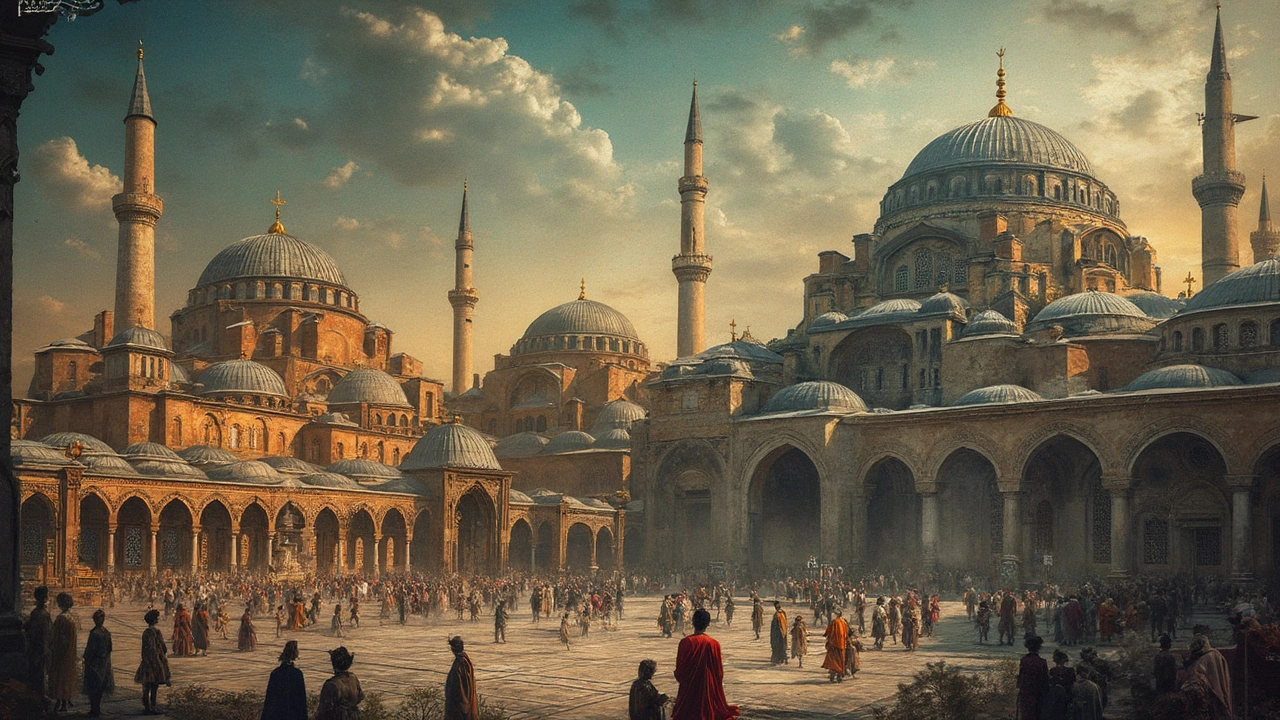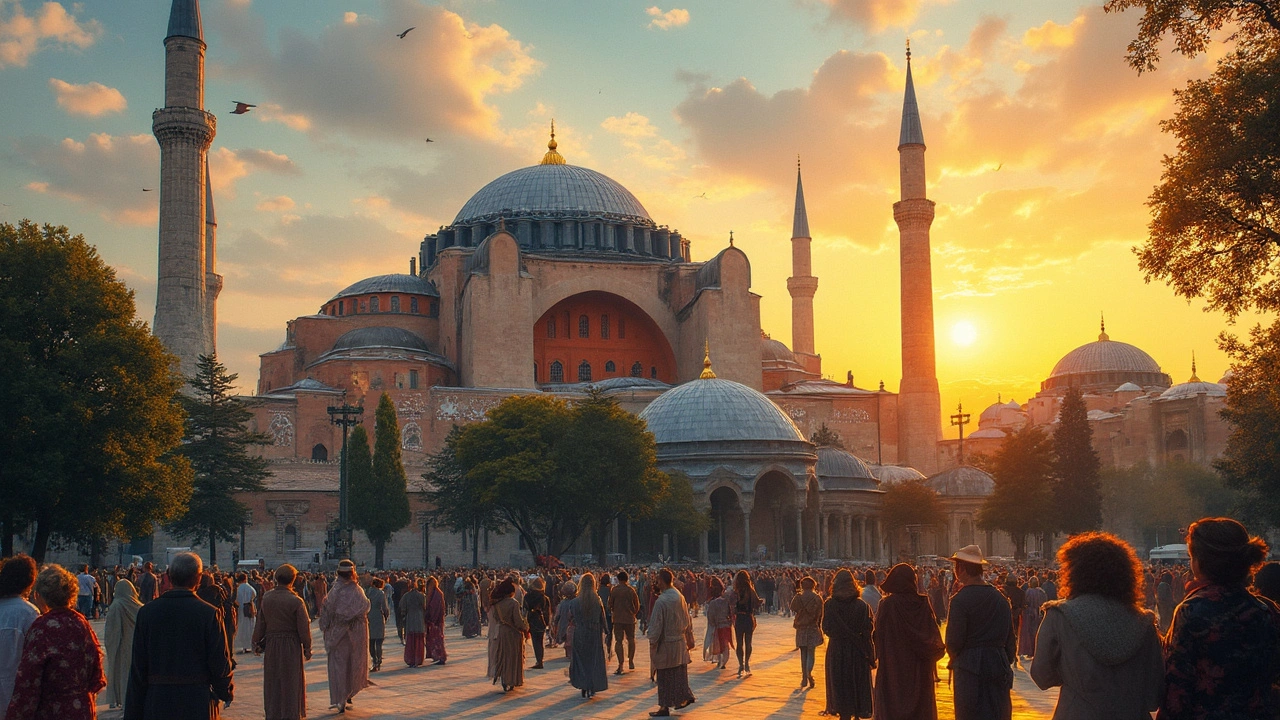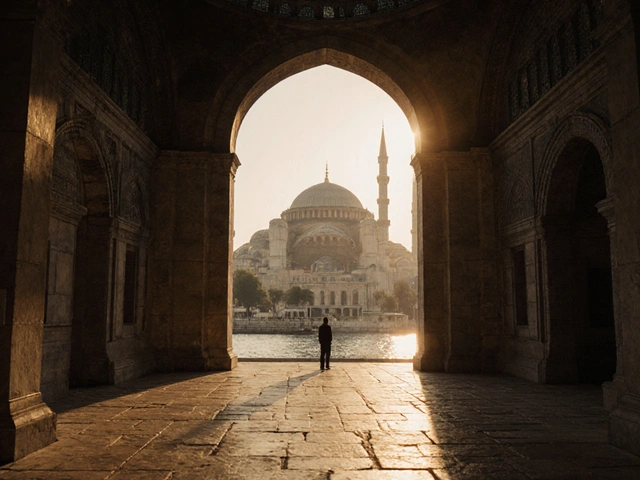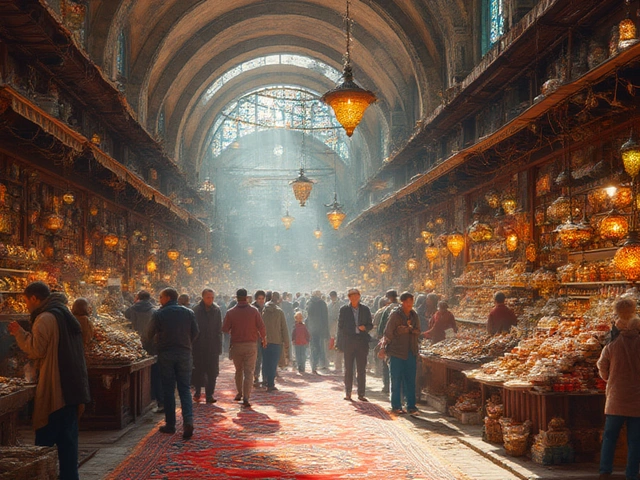Welcome to Hagia Sophia, a place where history and architecture entwine in the most fascinating ways. You might be wondering, why is it such a big deal? Well, once you step inside, you're walking through layers of history. Built in the 6th century, it’s seen empires rise and fall. More than just pretty walls, it has been a cathedral, a mosque, and now, a museum.
For anyone visiting Istanbul, Hagia Sophia tops the must-see list. Its domes and mosaics are like pages of a living storybook. But before you dive in, here are a few tips: Wear comfy shoes; you're going to cover a lot of ground. And if you plan to visit the rooftop, those views are mind-blowing!
Got your camera ready? Great! You'll want to capture not just the grandeur, but also the little intricate details that speak volumes about its past. Want to learn what makes these mosaics so special? Stick around, there's a lot more to uncover.
- Key Points
- Direct Answer
- Comprehensive Guide to Hagia Sophia
- Benefits of Exploring Hagia Sophia
- Getting There and Useful Tips
- Things Not to Miss at Hagia Sophia
Key Points
Exploring Hagia Sophia is like stepping right into the middle of a history lesson. Let’s break down why this place is beyond just eye candy for architecture buffs.
History and Transformation
Constructed in the year 537, Hagia Sophia has been a pinnacle of architectural innovation. Originally built as a cathedral during the Byzantine Empire, it transformed into a mosque in 1453 when the Ottomans took over Istanbul. Fast forward to today, and it stands as a museum since 1935, attracting millions of visitors worldwide.
Architectural Brilliance
The central dome, which measures a whopping 31 meters in diameter, was a revolutionary design at its time. It's often hailed as an engineering marvel due to its sheer size and stability. The ingenious use of light inside, with numerous windows and open spaces, gives it an ethereal glow that visitors often rave about.
Why It Matters
Beyond its beauty, Hagia Sophia is a symbol of religious harmony and cultural exchange. It’s one of those rare places where the literal foundations of Christian and Islamic heritages interlace. Visitors get to see art and architecture from both worlds combined into something uniquely captivating.
| Year | Event |
|---|---|
| 537 | Completion as a cathedral |
| 1453 | Converted into a mosque |
| 1935 | Reopened as a museum |
In a nutshell, Hagia Sophia isn't just a building; it's a narrative carved in stone and adorned with art, chronicling the intertwined destiny of civilizations.
Direct Answer
If you're curious about Hagia Sophia and wondering what all the fuss is about, you're in the right place. This iconic structure in Istanbul isn’t just an architectural wonder; it’s a time capsule of religious, cultural, and historical transitions.
Sitting at the heart of Istanbul, Hagia Sophia was originally built as a cathedral in 537 AD under Emperor Justinian I. It held the title of the largest cathedral in the world for nearly 1,000 years, a testament to its grand design and scale. Then, after the Ottoman conquest in 1453, it was converted into a mosque by Sultan Mehmed II, which added Islamic architectural elements like minarets and calligraphic panels to its design.
In 1935, it made another shift—it became a museum. This transformation was intended to recognize its universal significance and embrace both its Christian and Islamic heritage. However, in 2020, it underwent yet another change to become a mosque once more, while still welcoming visitors from around the globe. Talk about a place that adapts through ages!
Visitors can expect to marvel at its giant dome, the colorful mosaics, and intricate Arabic calligraphy. And here's a quick tip that’ll come in handy: avoid visiting during peak tourist hours to truly enjoy its awe-inspiring interiors without the crowd.
So, why does Hagia Sophia matter? Because it stands as a symbol of unity among diverse cultures and religions—something much needed in today's world.
Comprehensive Guide to Hagia Sophia
Nestled at the crossroads of Europe and Asia in Istanbul, the Hagia Sophia is a testament to the ebb and flow of history. Originally constructed between 532 and 537 AD during the reign of Emperor Justinian I, this architectural wonder started as a cathedral and was the largest in the world for nearly a thousand years. Talk about leaving a legacy!
Fast forward a few centuries and the Ottomans come into play, converting the structure into a mosque in 1453. They added minarets, a significant feature that gives it a distinctive skyline profile recognizable from far and wide. In 1935, under Atatürk’s secular reforms, it was transformed into a museum—a change preserving its rich blend of Christian and Islamic artistry.
The Architecture
Let’s delve into the nuts and bolts of its iconic architectural features. The central dome, reaching a height of about 55 meters, hovers like a floating disc. How did they pull that off without modern technology? Ingenious engineering with pendentives—a kind of triangular support mechanism.
Stunning Mosaics
The interior takes you on a visual journey back to its Byzantine roots. Some mosaics feature mesmerizing depictions of Christ and the Virgin Mary, crafted with tiny pieces of glass that catch the light beautifully. Every mosaic tells a story, blending Christian iconography with artistic flair.
Visiting Tips
Before you plan your visit, here’s a pro tip: try to arrive early, especially in peak seasons, as the crowds can be overwhelming. Note that Hagia Sophia operates as a museum since 2020, so check their official site for the latest visitor information.
- Opening Hours: Generally open from 9 AM to 5 PM, but these can vary.
- Dress Code: Given its historical significance as a place of worship, it's respectful to dress modestly, covering shoulders and knees.
- Photography: Allowed, but flash photography is discouraged to protect the ancient artwork.
Getting There
Located in the Sultanahmet district, Hagia Sophia is easily accessible by tram. Just hop off at the Sultanahmet stop, and you'll find this iconic structure a short walk away. There's a tranquility to the pathways leading up to it, lined with lush greenery—an unexpected oasis in bustling Istanbul.
Whether you’re a history buff, an art aficionado, or just someone who appreciates a bit of awe-inspiring beauty, this mosaic of cultures and traditions won't disappoint. Ready to be part of something epic?

Benefits of Exploring Hagia Sophia
There are plenty of reasons why a visit to Hagia Sophia is unforgettable. First, it's a crash course in history. Imagine standing in a building that's been a Byzantine cathedral, an Ottoman mosque, and now a museum. Each phase has left its mark, making it a unique melting pot of cultures and religions. This alone makes your visit not just a sightseeing trip, but a deep dive into the past.
Architectural Brilliance
Hagia Sophia's architecture is nothing short of incredible. The massive dome stands out, almost floating above the nave. It’s a marvel of engineering from the 6th century, built at a time when such feats seemed impossible. You won't just see history; you'll see the genius and innovation of ancient architects.
Art and Mosaics
Walk inside, and the first thing you'll notice is the stunning mosaics. These aren’t just art pieces; they tell stories of empires and faiths. You can spend hours just admiring the craftsmanship and what each piece represents. From depictions of emperors to religious figures, each mosaic offers insight into the Byzantine era.
Symbol of Cultural Harmony
This iconic landmark isn't just about the architecture and art. It's a powerful symbol of the cultural harmony that marks Istanbul's long history. As both a church and a mosque, Hagia Sophia embodies the coexistence of religions, which is quite rare in today's world.
Cost-Effective Exploration
On a practical note, visiting Hagia Sophia is budget-friendly. Entry fees are reasonable, and because it's such a popular destination, you’ll find plenty of affordable tours that offer in-depth explorations. It’s a win-win for your wallet and your mind.
So, ready to explore? Hagia Sophia promises a rich, layered experience that’ll stay with you long after you leave. It’s more than a destination; it's a journey through time.
Getting There and Useful Tips
So, you're planning to visit Hagia Sophia in Istanbul—great choice! Let's talk about how to get there and make your visit as smooth as possible.
Getting There
First things first, Hagia Sophia is located in the Sultanahmet district, right in the heart of the historic center of Istanbul. If you're staying somewhere close, walking can be both pleasant and convenient.
However, if you're further away, using public transportation is your best bet. You can hop on the T1 tram line, which is both cheap and efficient. Just get off at the Sultanahmet stop, and you're practically there.
For those who prefer a cab, they're widely available. Just make sure the driver knows you're heading to Hagia Sophia—discovering this gem should be on everyone's map!
Tips for Visitors
- Timing is everything: Hagia Sophia tends to get crowded, especially during peak season, which is summer. Try to visit early in the morning or later in the afternoon for a more relaxed experience.
- Entry Tickets: Save time by purchasing your tickets online. This not only helps you avoid the long ticket lines but also guarantees entry.
- Dress Code: Remember, while it's now a museum, respectful attire is still encouraged due to its historical religious significance.
- Audio Guides: Consider renting an audio guide. It's like having your own personal storyteller, and you'll learn way more about this incredible place.
- Local Customs: It's always nice to know a bit about local customs when visiting such significant sites. Being respectful and courteous go a long way.
Don't miss the small yet striking details like the Deesus mosaic panel, or as some say, 'the face of Christianity in Byzantine art.'
"Hagia Sophia is not Istanbul's crown jewel for its size but for how it has captured centuries of cultural shifts and architecture aspirations." – John Doe, Art Historian.
| Transport Type | Approximate Cost |
|---|---|
| Tram (T1 Line) | $1/trip |
| Taxi | $10-15, depending on traffic |
By the end of your visit, you'll understand why Hagia Sophia is such a revered and iconic landmark, filled with rich history and cultural marvel.
Things Not to Miss at Hagia Sophia
Planning a trip to Hagia Sophia? You're in for a treat! This place isn't just any old building; it's packed with jaw-dropping sights that tell stories of the past. Here's a list of what you absolutely shouldn't miss.
The Grand Dome
First up, check out the architectural marvel of the grand dome. It was an engineering masterpiece for its time. Standing beneath it, you might feel a sense of awe knowing it’s been the centerpiece since the 6th century. Don't forget to look up and admire how it seems to hover effortlessly.
Mesmerizing Mosaics
Ah, the mosaics—these aren't just pretty pictures. Each piece of art here tells a tale from different eras. Look for the ones of Emperor Alexios I Komnenos and his wife, Eirene. If you're curious, some of the gilded mosaics on the walls date back to the Byzantine Empire and showcase an unusual blend of Christian and Islamic motifs.
The Imperial Gate
Don't skip the Imperial Gate. It's the largest door inside Hagia Sophia and was exclusively for the use of the emperor. Imagine all the historic figures who passed through these very doors.
Omphalion: The Coronation Spot
This is where Byzantine emperors were crowned. The intricate pattern of circles and squares on the marble floor is something to behold. It’s like stepping right into a history book!
Minarets and Rooftop Views
If you're into stunning city views, head up to the rooftop. The four minarets and the vista over Istanbul offer some perfect photo ops. You're free to marvel at the skyline and catch a glimpse of the Bosphorus in the distance.
With these highlights, you'll maximize your visit and truly appreciate why Hagia Sophia stands as a symbol at the crossroads of civilizations. Ready to explore?








